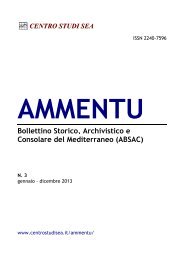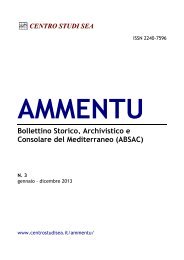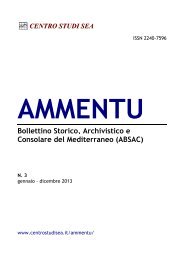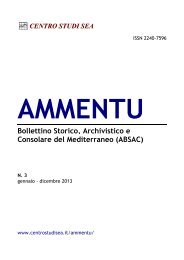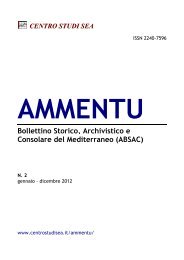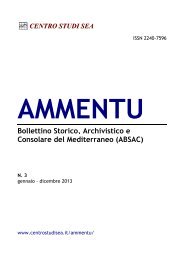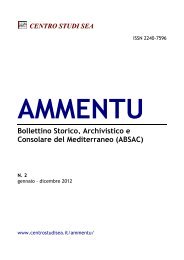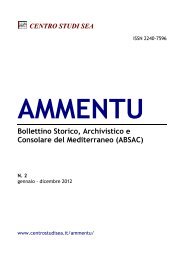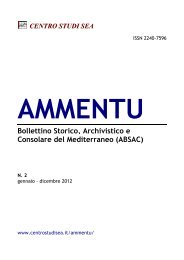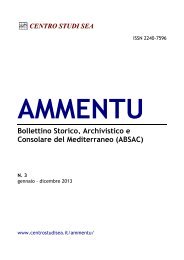le terme di Sardara all'inizio del XX secolo - Centro Studi SEA
le terme di Sardara all'inizio del XX secolo - Centro Studi SEA
le terme di Sardara all'inizio del XX secolo - Centro Studi SEA
Create successful ePaper yourself
Turn your PDF publications into a flip-book with our unique Google optimized e-Paper software.
Roberto IbbaLe élite sarde e l’acqua calda: <strong>le</strong> <strong>terme</strong> <strong>di</strong> <strong>Sardara</strong> all’inizio <strong>del</strong> <strong>XX</strong> <strong>secolo</strong>Roberto IBBAUniversità <strong>di</strong> CagliariAbstract<strong>Sardara</strong> thermal baths contemporary history begins at the end of the nineteenth centurywhen Filippo Birocchi and Giorgio Asproni Junior project for the thermal resort constructionhas been approved. Birocchi’s death <strong>di</strong>dn’t stopped the route outlined: <strong>Sardara</strong> thermal bathsopened in 1901. In the 1920s the thermal bath management and the claim for the waterexploitation has been made over to Libero Rodriguez, a businessman from Ig<strong>le</strong>sias. In the 50sthe precious resource management has been entrusted to Dr. Mario Mossa.Keywords<strong>Sardara</strong>, thermal baths, spas, spa, élite, mining law, mining claimEstrattoLa storia contemporanea <strong>del</strong><strong>le</strong> <strong>terme</strong> <strong>di</strong> <strong>Sardara</strong> inizia alla fine <strong>del</strong> XIX <strong>secolo</strong> quando vieneapprovato il progetto <strong>di</strong> Filippo Birocchi, che in società con Giorgio Asproni Junior, inizia lacostruzione <strong>del</strong>lo stabilimento terma<strong>le</strong>. La morte <strong>di</strong> Birocchi non interrompe il percorsotracciato: lo stabilimento apre nel 1901. Negli anni Venti la gestione <strong>del</strong><strong>le</strong> <strong>terme</strong> e laconcessione per l’utilizzo <strong>del</strong>l’acqua sono ceduti a Libero Rodriguez, impren<strong>di</strong>tore <strong>di</strong> Ig<strong>le</strong>sias.Il dott. Mario Mossa negli anni Cinquanta subentra, tra alterne vicende, nella gestione <strong>del</strong>lapreziosa risorsa.Paro<strong>le</strong> chiave<strong>terme</strong>, <strong>Sardara</strong>, élite, <strong>le</strong>gge mineraria, concessione mineraria1. Le <strong>terme</strong> <strong>di</strong> <strong>Sardara</strong> nell’OttocentoIl 24 febbraio 1898 il notaio Reginaldo Anchisi vergò su un atto pubblico l’accordo trail Comune <strong>di</strong> <strong>Sardara</strong>, rappresentato dal sindaco Don Filiberto Diana, e il cav. FilippoBirocchi, per lo sfruttamento <strong>del</strong><strong>le</strong> sorgenti termali <strong>di</strong> Santa Maria de is Acquas 1 .L’accordo fu l’ultimo atto <strong>di</strong> un percorso accidentato che ha interessato l’area e <strong>le</strong>sorgenti per tutto il corso <strong>del</strong> XIX <strong>secolo</strong> 2 .Nel 1805 Carlo Felice, allora ancora soltanto Duca <strong>del</strong> Genevese, scrisse al re perevidenziare il penoso stato in cui versavano <strong>le</strong> strutture dei bagni, frequentati datantissime persone. Il sovrano decise, dunque, <strong>di</strong> assegnare alla riparazione dei bagniil prodotto <strong>del</strong>la roa<strong>di</strong>a, ma per anni il prob<strong>le</strong>ma <strong>del</strong><strong>le</strong> <strong>terme</strong> fu accantonato.Venne ripreso solo nel 1831 dalla Giunta per il Vaccino, organismo nato nel 1828 permonitorare e coor<strong>di</strong>nare <strong>le</strong> condotte me<strong>di</strong>co-chirurgiche, che nella sua relazioneannua<strong>le</strong>, espresse la necessità <strong>di</strong> rendere nuovamente operative <strong>le</strong> <strong>terme</strong> <strong>di</strong> <strong>Sardara</strong>e la sorgente <strong>di</strong> San Martino a Codrongianus 3 .Tra il 1834 e il 1835, la Segreteria <strong>di</strong> Stato e l’Intendenza Genera<strong>le</strong> si mossero peraffidare l’incarico <strong>di</strong> restauro <strong>del</strong>l’e<strong>di</strong>ficio <strong>del</strong><strong>le</strong> antiche <strong>terme</strong> romane all’ingegnerOrunesu, peraltro già oberato da altri impegni, il qua<strong>le</strong> tardò a visionare lo stato deibagni. Nel 1839 il consiglio comunitativo, in seduta straor<strong>di</strong>naria, approvò un1 L’atto si trova in <strong>di</strong>verse copie: nell’Archivio comuna<strong>le</strong> <strong>di</strong> <strong>Sardara</strong> e ARCHIVIO DI STATO, CAGLIARI (d’ora in poi AS CA),Atti sciolti, notaio Reginaldo Anchisi.2 L’intero carteggio <strong>del</strong>la vicenda dei bagni termali <strong>di</strong> <strong>Sardara</strong> è conservato in AS CA, II serie, Vol. 81. Le principalipubblicazioni <strong>di</strong> riferimento sono: ABRAMO ATZORI, <strong>Sardara</strong> e il suo santuario mariano, <strong>Sardara</strong> 1992; GIOVANNI DEFRANCESCO, Cronache sarde: <strong>Sardara</strong> e <strong>le</strong> sue <strong>terme</strong>, Valdes, Cagliari 1903; ANGELO MASCIA, Le <strong>terme</strong> <strong>di</strong> <strong>Sardara</strong> nellaSardegna <strong>del</strong>l’800, E<strong>di</strong>zioni <strong>del</strong>la Torre, Cagliari 1995.3 AS CA, Segreteria <strong>di</strong> Stato, II serie, Vol. 81.250



